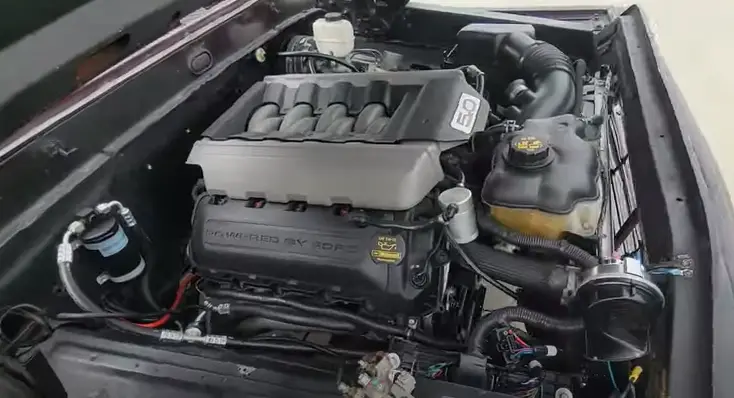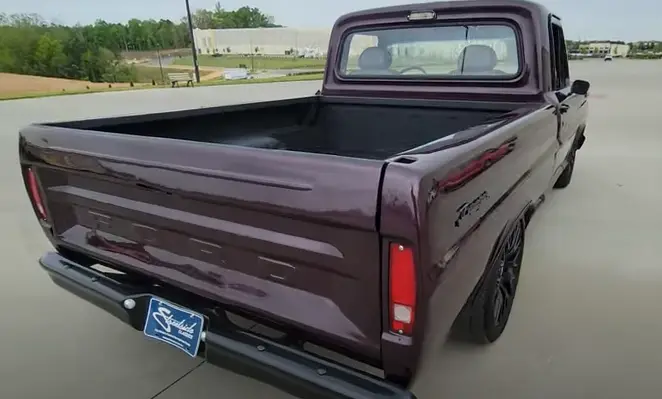The iconic 1969 Ford F100 served as evidence of the survivability of the country boy. You truly needed to have strong arms to guide it across tough terrain because the seats were fixed. It essentially tells the tale of the majority of vintage early pickup vehicles.
These 1969 ford F100 pickup trucks embodied the hardscrabble way of life of the countryside. With its original compact V-8 and dual front suspension, it also had the strength to prove it despite the fact that numerous car models also had straight-6 and inline engines. Ford later chose downsized turbo engines and the first aluminum bodywork in the industry.
1969 Ford F100: Dimensions

| Length | 12/92 in. |
| Overall Width Without Mirrors | 72 in. |
| Height | 60 in. |
| Wheel Base | 120 in. |
| Seating Capacity | 3 |
| Curb Weight | 3060 Lbs. |
| Tires Type | 4PR |
| Tires Size | 8.15 x 15 |
1969 Ford F100: Exterior Features
These older F100 bodies typically include modifications beneath the hood and under the chassis. Older or more powerful vehicles are always worth more than newer ones. The Ford F-100 is always the most seasoned model. It looks far better in terms of features and style than the most recent Ford models, thanks to its aluminum frame and ergonomic design.
1969 Ford F100: Exterior Body Styles
| Style side pickups | Flareside Pickups |
|---|---|
| The sleek, flank body panels that extend to the rear cab corners of the 1969 Ford F100 are available in several length choices. The tailgate can be opened fast and effortlessly thanks to its simple single-center latch system. Additionally, it offers the choice of flat top wheel housings, which is an added benefit for a good load capacity. | Additionally, there are three different body lengths for fireside pickups. It makes running boards and rear fenders available for simpler loading, allowing for the utilization of more cargo space. When the tailgate is closed, latches of the toggle type maintain a tight seal, while foam forged steel links sustain the tailgate when it is open. As a result, it gives the vehicle extra strength and rigidity. |
1969 Ford F100: Interior Features
No other Ford car has ever been created with a more spacious interior than the 1969 Ford F100. It has particularly plush, deeply padded seats that are made to juxtapose with the outside paintwork. It has energy-absorbing sun visors, an instrumentation panel with padding, and energy-absorbing armrests. Windscreen washers, rearview mirrors, rearview lights, signal lights, and safety flashers are also included as standard equipment. Along with hardwood plywood headlining, a black floor mat, and vinyl seat trim in black, blue, and red, it also has a plush interior.
1969 Ford F100: Colors
| EXTERIOR COLORS | INTERIOR COLORS |
|---|---|
| Raven black, Wimbledon white, Norway Green, New Lime, Boxwood Green, Candy apple Red, Royal Maroon, Pebble Beige, Cordova Coper, Empire Yellow, Lunar Green, Reef Aqua, Sky view blue, Harbor Blue, Chrome yellow, Pure White | Medium stone, Ebony (Cloth and leather) |
1969 Ford F100: Motor Options

| Specifications | 240 SIX | 300 SIX | 360 V8 | 390 V8 |
|---|---|---|---|---|
| Horsepower | 150 hp @ 4000 rpm | 165 hp @ 3600 rpm | 215 hp @ 4400 | 255 hp @ 4400 rpm |
| Torque | 234 lb. ft @ 2200 rpm | 294 lb. ft @ 2000 rpm | 327 lb. ft. @ 2600 rpm | 376 lb. ft @ 2600 rpm |
| Compression ratio | 9.2 | 8.8 | 8.4 | 8.6 |
| Bore and Stroke (in.) | 4.0 x 3.18 | 4.0 x 3.98 | 4.05 x 3.50 | 4.05 x 3.78 |
1969 Ford F100: Towing Capacity

| Base Engine Type | Gas |
| Base Engine Size | 6.4 L |
| Cylinders | V6 |
| Horsepower | 255 hp @ 5,000 rpm |
| Torque | 470 lb. -ft @ 2,250 rpm |
| Valves | 24 |
| Drive Type | Rear wheel drive |
| Transmission | 3 Manual overdrive T-85 |
1969 Ford F100: Gas Mileage
| Fuel type | petrol |
| Fuel tank capacity | 74 gal. |
| Max Towing Capacity | 5,000 lbs. |
| Max Cargo Capacity | 76.4 cu. Ft. |
Recommended Reading | 1954 Ford F-100
1969 Ford F100: Air Conditioner
The air conditioner cars come with a lot of assistance to work with. Therefore, the issues that the air conditioner might be facing could be because of malfunctioning of these parts. Some of these parts that could cause hazards are:
- Vents and Knobs: You may have an electrical problem if the buttons or knobs used to operate the air conditioning aren’t functioning.
- Fan Motor: It could be a sign of an electrical short or another issue with the blower’s motor.
- The vacuum system: A vacuum system regulates the temperature and airflow of the atmosphere. It’s time to inspect the controls and supply routes for this equipment if the knobs, vents, breakers, and fans all appear to be functioning properly.
- Wires and Hoses: You will only receive recycled air from beneath the hood through the climate control vents if these components are damaged or improperly linked, which is not beneficial on a hot day.
- Belt Drive: It is necessary to fix or replace a belt that is worn, sliding, or broken. Another indication that the belt requires maintenance is if it makes noise when the air conditioner is running.
Why did Ford Stop Making the F100?
Ford F-100: Ford terminated the F-100 as it reorganized the vehicle lineup in 1983. Because the Ford F-150 offered everything the F-100 did and a little bit more, the Ford F-100 was withdrawn in 1983. The tilt-cab C-Series took the place of the cab-over F-Series, which was discontinued. Ford started manufacturing four-wheel drive pickup trucks in-house in 1959. To put it simply, the Ford F-Series was renamed and improved into the Ford F-150.
1969 Ford F100: Special Models
| Contractor Special | Ranch Special |
|---|---|
| Heavy duty front and rear springs | heavy duty battery, alternator, front and rear springs |
| Dual chrome swing lock | bright body side moldings |
| Western Lock mirrors | 9″ high side cargo boards |
| rear step bumper | rear step bumper |
1969 Ford F100: Present Value
It’s really difficult to find an F-100 model from those years. Models that need to be restored might cost anything from $25,000 and $100,000, depending on how it will be done. The earliest model prices were $2430 during the time of manufacturing.
1969 Ford F100: Reviews and Ratings
The 1969 Ford F100’s strength is incredible. No matter your degree of car experience, these trucks are quite simple to work on, and the parts are very affordable. It is constantly charged to keep operating for a long distance, much like any other Ford model.
FAQs on 1969 Ford F100
What is the gas mileage of the 1969 Ford F100 model?
The combined average MPG for the 1969 Ford F-100 is 9.64.
Where is the gas tank located in the 1969 Ford F100?
The gas tank is located in the place where the gas tank lid is seen on the exterior wall of the car.
Where is the 1969 Ford F100 voltage regulator located?
The voltage regulator is often fitted to or housed inside the alternator on most cars.
Does the ’69 Ford F100 has grills?
Yes, the model does have rills that were used for other 1969 second-generation models.
What is the cost of a 1969 Ford F100 ignition key?
The cost of an ignition key ranges from $18-$30
Conclusion
The new 1969 Ford F100 trucks are not intended for everyday usage by humans but rather for commercial use or for hauling large goods like horses, fifth wheel trailers, and cement mixers. Therefore, all you need to know is here if you’re seeking to determine where a vehicle this powerful can be employed.
